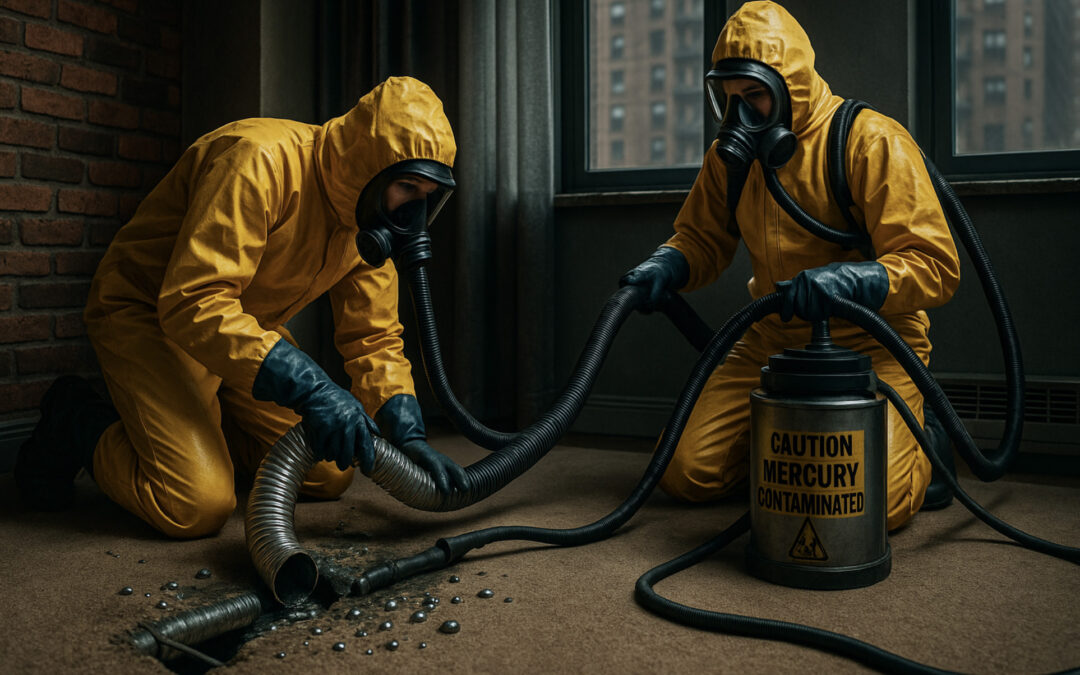When Mercury Flows from the Ceiling: A Hazmat Call That Was Anything But Routine
You know that feeling when a call comes over and just doesn’t seem real? That’s exactly what happened on this particular Sunday when the ticket read “mercury leaking from an air conditioner.” Myself, Mike Monaco, and Bobby Salvesen weren’t on the job that day, but our guest, John Cassidy, was. A Lieutenant with FDNY Hazmat Company 1, John’s the kind of guy who’s forgotten more about hazmat than most of us will ever know.
What started as a call we’d usually dismiss as a “boomerang” (you go out, take a look, and are back in the firehouse before the coffee cools) turned into a six-hour scene, a criminal investigation, and years of legal follow-up. Here’s the story – told from John’s sharp memory and our many laughs along the way.
Mercury? In an HVAC System? Mercury’s not something you expect in a modern air conditioning system. Sure, older thermostats had mercury switches, but HVAC systems? Not likely. So when the team arrived and saw mercury beads on the floor beneath the ceiling vent, there was confusion.
As John recalled, the mercury vapor analyzers were “screaming at the door.” That’s always a bad sign. It wasn’t just a couple of beads either – every room in the house was over acceptable limits, even the attic. That’s when things really started to unfold.
The homeowners, trying to clean the spill themselves, made things worse by using their built-in central vacuum system, which essentially blew mercury vapor through PVC piping into every corner of the house.
“Instead of just bagging a vacuum, now you’ve got mercury in every pipe inside the walls,” John said.
And to make matters worse, this wasn’t a small drop from a broken thermometer. There were multiple pockets of mercury found throughout the HVAC system – including a return vent, a main distribution unit in the attic, and ductwork in nearly every room.
A Scene from a Hazmat Horror Show Think about how mercury behaves. It beads up, sure, but when it drops from even a few feet, it shatters into microdroplets – dramatically increasing surface area and, with it, the potential for vaporization. Mercury vapor is heavy, so it settles low, meaning pets and small children are at the greatest risk.
That played out tragically here: the family dog died.
Residents were also showing early symptoms – headaches and dizziness. One woman in the home was pregnant, raising immediate concerns about fetal exposure. The team wisely advised the family to evacuate and seek medical evaluations.
Despite hours of cleanup, ventilation, and fan operations, vapor levels wouldn’t drop. The mercury had become embedded in rugs, curtains, floors, ductwork – you name it.
From Cleanup to Criminal Court as if the physical cleanup wasn’t enough, the story took a sharp turn into the legal world.
The homeowner alleged this was intentional sabotage by an HVAC contractor he was in a dispute with. That’s when things escalated to multi-agency involvement – DEC Police, the NYC Department of Health, and local law enforcement. What was suspected as a vendetta became a potential criminal case of environmental poisoning.
And this is where Cassidy’s training came into play in a whole new arena: the courtroom.
He found himself testifying against a former John Gotti defense attorney, who tried to poke holes in everything from instrument calibration to when the mercury analyzer filter was last changed. But because John and the team had kept solid documentation, knew their meters inside and out, and could explain the science clearly, the testimony held up.
Despite all of that, the technician was acquitted. The judge felt the evidence couldn’t conclusively prove who placed the mercury there. Still, the case emphasized the importance of one key point:
“Every report you file might be Exhibit A in a courtroom someday.”
Tactical Takeaways: What This Run Teaches Us
This wasn’t just a run gone sideways. It was a showcase of how hazmat response, when done right, demands both tactical excellence and legal precision.
- Understand the science. Know how substances behave and spread. Mercury’s low vapor pressure doesn’t mean it’s safe – it just means it’s sneaky.
- Never trust a vacuum. Especially a built-in one. A vacuum turns a localized spill into a house-wide problem.
- Monitor from the door. Air monitoring from the moment you arrive can protect your team and reveal surprises early.
- Document everything. When court comes calling, your paperwork is your best defense.
- Coordinate early. Bring in public health, environmental agencies, and law enforcement before you’re in over your head.
The Long Game: Hazmat Doesn’t End at the Scene
The call happened in 2015. The court case? 2018. And Cassidy’s still sharing lessons from it in 2025. That’s how long the tail of a hazmat call can be. Most of us assume the run ends when we get back to the firehouse – but in cases like this, it echoes for years.
“You never think your readings will be cross-examined in court,” said John. “But they were.”
This incident also shows how vulnerable everyday families are to environmental toxins. If this hadn’t been caught, they could have suffered chronic mercury exposure for months – or years – without ever knowing.
Conclusion
This story isn’t just about mercury. It’s about preparedness, professionalism, and protecting people from invisible dangers. If you work in hazmat, you can’t afford to treat any call as routine.
So here’s the challenge: Have you reviewed your documentation protocols lately? Do your team members know their meters well enough to teach a lawyer about them? Could you stand behind your report in a courtroom years after a run?
If the answer’s “not sure,” maybe it’s time to tighten up.


